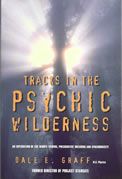|
Dale Graff's initial exposure to remote viewing occurred when he worked in the Foreign Technology Division of the U.S. Air Force in the areas of physics and aerospace engineering in the 1970s. He later moved to the Defense Intelligence Agency (DIA) where he worked as a physicist. When the U.S. Army's remote-viewing unit moved to the DIA in 1985, he became the director of the program. Mr. Graff was apparently the creator of the "Stargate" name that has been used to identify the remote-viewing project within the Department of Defense. He coordinated many of the activities that transpired between Dr. Harold Puthoff's remote-viewing laboratory at Stanford Research Institute (later SRI International) and the Department of Defense. In short, Mr. Graff was a central administrative figure in the U.S. military's remote-viewing program, and "Tracks in the Psychic Wilderness" is an important historical marker in the reporting of those government funded efforts to use remote viewing for espionage purposes. Mr. Graff's book has five parts. The first is his own recollection of the history of the U.S. military's remote-viewing program. While this initial section is only 17 pages long, it is nonetheless rich in useful detail. One comes away from this introduction with a sense that the U.S. government took its own remote-viewing program exceptionally seriously. Always worried that the program might cause embarrassment to the government if revealed to the public, the government nonetheless highly valued the results of the program while it lasted. The government occasionally used the military's remote viewers to successfully assist in resolving intelligence concerns which were of high importance. More often than not, when governmental officials decided not to pursue leads offered by the remote viewers, it was later discovered that the leads were accurate and that valuable time had been lost by not taking those leads more seriously. Mr. Graff does at good job at describing both sides of this dilemma, where results are valued for their own sake, but the source of information is problematic when reputations and career considerations become involved. Anyone who wants to retrace those early remote-viewing efforts by the U.S. government needs to read Graff's chronology of these events. The second part of this book is a telling of many of the primary experiences that Mr. Graff had that shaped his views on the remote-viewing phenomenon. A few of these experiences occurred when Mr. Graff worked with Dr. Puthoff at SRI. In some instances, the primary concern is to test how well remote viewing works for different types of targets, such as targets that are underground, or targets that are very distant from the remote viewer. In other instances, Mr. Graff is deeply concerned about exploring the potential for using remote viewing operationally, such as for the purpose of rescuing lost explorers. Here we see his interest in both the basic science aspect of remote-viewing research as well as his interest in possible practical applications. Mr. Graph's third section in his book is about remote-viewing via dreams. The book later ventures into the subject of things happening in a seemingly coordinated fashion, where the coordination seems to operate at least partially through the unseen realms of consciousness. He calls this "synchronicity," and I suspect many readers will find this discussion interesting, although it is not quite as well connected to the book's overall theme as his earlier focus on remote viewing. The final section of Mr. Graff's book is a section of practical tips for developing capabilities in remote viewing, dreaming, and synchronicity. In my view, the real gem of this book can be found in the first 75 pages, where Mr. Graff discusses both the history of the U.S. military's remote-viewing efforts as well as his own set of profound experiences involving remote viewing. The fact that this book is written by a director of the military's program is significant by itself. Readers will likely find this book to be a useful introduction to these interesting events. But I suspect that readers will also find Mr. Graff's description of his own reactions to profound remote-viewing experiences which he witnessed both in the laboratory as well as operationally in the military to be a useful reminder that the remote-viewing phenomenon itself is one that does not leave anyone unaffected. The realization that remote viewing is a real phenomenon nearly always is accompanied by a re-evaluation of the nature of existence, and the human spirit. |

